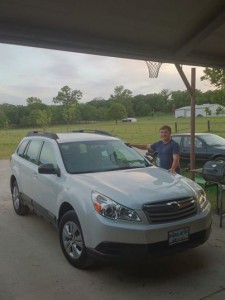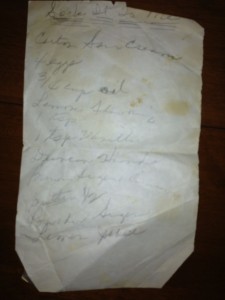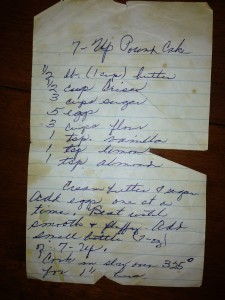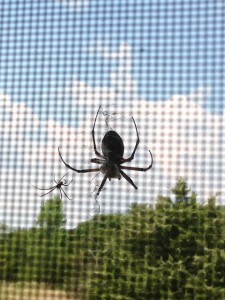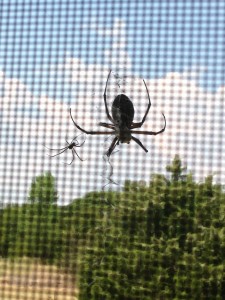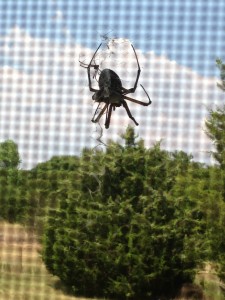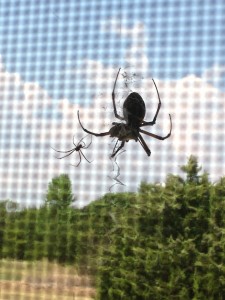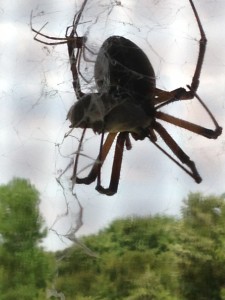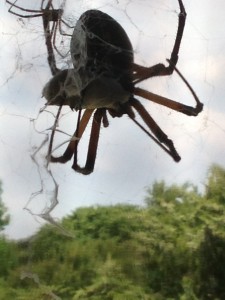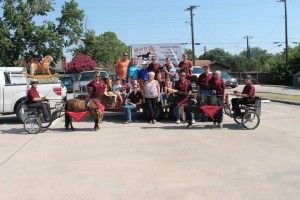Uncategorized
Overheard in the Wolfe House #267
Out like a lion
Tomorrow is the first day of April and the first day of autism awareness month. I don’t think I will participate in the blue-washing this year.
This month has been filled with numbers. I was going to funny-blog about one of them — passing the 2,000-mile mark on my running odometer — but now I don’t have the heart.
I distance run because my friend, Susan Sullivan, got sick. She is known to many as Runner Susan, for her running blog that turned into a shale blog for a bit after she got sick. She had to have a hysterectomy because her girl parts were filled with tumors. I told her, when she was recovering, that I would run with her when she got well. I’d already lost some of my girl parts by then. More than two years later and we are still running together.
Ever since Sam was a toddler, I’ve been running a different kind of run with Sam. When he was born, autism was rare, about 1 in 10,000 to 15,000 births. This month, the Centers for Disease Control and Prevention came out with a new estimate: 1 in 68.
That number represents a financial burden that will crush us. The estimated lifetime cost of raising and caring for a person with autism is $1.4 million, compared to about $250,000 to raise a normal child. When today’s kids with autism are adults, there will be just 67 other people for each to help shoulder the burden.
If our kids are the canaries in this coal mine of environmental assaults, this run-away incidence rate clearly hasn’t been the bitch-slap policymakers need. I cannot understand why they can bring themselves to regulate with the precautionary principle sometimes and not others.
If the need is for more immediate threats, like people, even kids, getting cancer, that doesn’t seem to be driving the message home either. In the Virginia Environmental Law Journal, University of Texas professor Rachael Rawlins had things to say this month about the health impacts of shale development on policymakers. The UT press office summed it thusly:
Rawlins examines the Texas Department of State Health Service’s cancer cluster analysis conducted in response to parents’ concerns about seemingly excessive cases of childhood leukemia in the suburban community of Flower Mound. Although the state acknowledged that gas industry emissions include benzene, a carcinogen known to be associated with leukemia, the state dismissed further analysis with a preliminary study after concluding that it was not able to confirm with 99 percent certainty that cancer rates were significantly elevated in Flower Mound, Rawlins writes. Rawlins explains that, even when the state confirmed elevated rates of breast cancer with 99 percent certainty, it was too quick to dismiss the possibility of an association with toxic emissions.
The article reports on a reanalysis of the state’s data prepared by UT Austin researchers in collaboration with Dr. Maria Morandi, a faculty affiliate and former research professor from the Center for Environmental Health Sciences at the University of Montana. The reanalysis found, with 95 percent certainty, that rates of childhood leukemia and childhood lymphoma in Flower Mound are significantly higher than expected; there is only a 1 in 20 chance that the difference is random. In science, 95 percent certainty is considered the norm.
(Oh, yeah, the old breast cancer story. Now where did Josh Fox and the Merchants of Doubt over at the Associated Press move the boxing ring for that story again? Wait, wait, don’t tell me it’s time for my annual defense again.)
I’m feeling dark today. March is going out like a lion and I just don’t feel like lighting it up blue. But you all go ahead and have fun.
It’s gonna be a Merry Christmas y’all.
Sam is one of Santa’s best elves.
Day:
Night:
Old-school cakes: Sock-It-To-Me and 7-Up pound cakes
At last weekend’s Denton Blues Festival one vendor was selling Sock-It-To-Me cake and I was reminded of reams of recipes Regina had for cakes.
There were so many we didn’t take the time to talk about all of them, but occasionally one would capture Regina or Patti’s imagination. Regina said Sock-It-To-Me was so good.
Regina must have made Sock-It-To-Me cake a lot, because this was her recipe.
(You might be better served finding a recipe elsewhere. I’m told it’s often printed on the box of Duncan Hines cake mix, the way that the recipe for Rice Krispies squares is usually on the cereal box. But I also have seen from-scratch recipes for it on baking blogs, too.)
When we found the 7-Up pound cake recipe, Patti said it was good, but she wasn’t making it anymore because she couldn’t find 7-Up in the store. “And don’t make it with Sprite. I tried. It’s TERRIBLE,” Patti said.
Regina said she gets 7-Up at the dollar store all the time.
I bake cakes from scratch, because cakes from mixes taste waxy to me. Many of Regina’s recipes are from scratch, but not all. My sister, Karen, and I wondered aloud if anyone who cooks seriously still cooks that way (clearly they do, there’s a quarter of grocery aisle committed to cake and frosting mixes). I think it’s interesting that to Regina’s way in the kitchen, if it was a good recipe, it survived. I don’t remember any cake she served ever tasting waxy.
Next week we’ll get back to DIY for the pantry.
Remembering a visit to the E.R.
Researchers have come out with a protocol for emergency room personnel who find themselves caring for a person with autism. I’m glad to see this.
In January 2009, I took Sam to the emergency room in the middle of the night.
He got a bladder infection. He came home from the first day of competition at Chisholm Challenge and was passing blood, which alarmed him. I told him we’d skip the second day of competition and see a doctor in first thing in the morning. But, he woke me up at 2 a.m., shaking uncontrollably and a little panicked.
Even though he’d just turned 21, the pediatrician was still his primary care doctor. So I phoned the nurse on call. Because he was exhibiting signs of shock, she told me to take him in. By the time we got there, he had stopped shuddering, but his urine sample was brown.
We’d gone to Baylor-Grapevine, which was a fairly new hospital at the time. He was already familiar with it because an occupational therapist working out of the rehab center there helped teach him to drive. (Big shout out to Cathy.)
I remained concerned. Would it be filled with people? Would the sounds of arriving ambulances distress him? I was worried most about the staff. Would they be brusk and stand-offish? Would he be hustled around? I didn’t have time to prep them the way I had prepped the many other doctors, dentists and health care givers in his life.
With the first interaction, I saw the lightbulb go off in the ER nurse’s head. She immediately adapted. And everyone who followed after her knew to take their time, be calm and explain each step.
We were lucky, too, that it was a quiet night. The visit wasn’t much different from one at a doctor’s office, except for reams more paperwork and the occasional paramedic tromping down the hallway.
Here’s what the research recommends and what I noticed the folks at Baylor-Grapevine already knew to do:
· Usher patients to a quiet, more dimly-lit room with less equipment
· Avoid multistep questions and stick to questions that require only a “yes” or “no” answer
· Communicate with the care giver or family member, if one accompanies the patient, to get an effective medical history
· Keep voice calm and minimize words and touch
· Let patients see and touch the instruments and materials that will be placed on their bodies
· Use a warm blanket to calm a patient down and administer mild doses of medication rather than physical restraints to quiet a patient
Parental Advisory. Don’t look if you have arachnophobia
Vaccines. Just do it.
Until I finished Seth Mnookin’s book, The Panic Virus, it never occurred to me that all of the autism community could face backlash in the future if the anti-vaccine movement continues to take its toll.
I don’t blame vaccines for autism. Scientists have been looking for connections for years and they haven’t found any. Autism rates are continuing to rise even though they removed the mercury preservative from vaccines years ago. And, the study that supposedly linked autism to the MMR vaccine was compromised. (That’s the short version of the science, for the exhaustive, researched version, reach for Mnookin’s book.) It’s distressing that people who should know better, and people in positions of trust, promote parent choice to withhold vaccines as somehow cautious and thoughtful.
It’s not.
This week, we learned of a serious local outbreak of the measles traced to the members of a church that holds an anti-vaccine position.
You wouldn’t take your child to the doctor and then not follow the treatment protocol. That would be heartless and irresponsible. Some people get as mad as a bumped bed of fire ants thinking about changes that could come because of the Affordable Care Act — mercy, you might have to wait for care, or be denied a high-cost treatment option in favor of something less expensive. But somehow you want a choice now, passing on a well-established protocol that prevents some of childhood’s killer diseases? That’s irrational, and irresponsible.
How irresponsible? Derek Bartholomaus keeps a body count.
How to be spontaneous
Sam got an email Friday giving him a day’s notice for a chance to ride on a float Born2Be would have in the North Texas Fair and Rodeo parade Saturday morning. He forwarded the email to me. I replied that I already had promised to run trail with Susan Saturday morning, but this looked like something fun he could do on his own.
When I got home from work that evening, he said he just didn’t think that a day’s notice was enough notice for him. Did he have to go to work Saturday? Did he have other plans? He said no. But, from time to time, through the evening, he would talk about the parade. I knew he was thinking about it.
Finally, I reminded him that in the movie, Mama Mia, the character, Harry, had a hard time being spontaneous, but he saw everyone else being spontaneous, so he wanted to try. Maybe you can try to be spontaneous like Harry, I told him.
Sam decided to call someone at B2B for more information, and went to bed early with a tentative plan of how he would fit the parade into his day. Sam’s right, a person does have to lay some groundwork to be spontaneous.
Saturday morning we all were up early, and he was ready to head out the door to get there in time to meet everyone else. He was home by lunch and said he had a great time.
“I’m spontaneous,” he said.
Link-and-Twist: ethical reporting on health impacts and breast cancer
Mark had this rule we lived by, and we did our best to pass on to the kids. If something makes you mad, don’t do anything about it for at least 24 hours. Oh, The Places You’ll Go! when you don’t go to your angry place. Usually, we found that we woke up the next day and couldn’t remember why we were bothered. Or, if something was still wrong, we could think it through and get it fixed.
Editors have a rule that, when someone asks to reprint a story, they have to print the whole thing. That’s smart. It keeps people from misappropriating your work, recasting it in a shape that fits them, or just flat-out stealing it.
For a while now, when it comes to my long-ago story on local breast cancer rates, I think I’ve been applying too much of Mark’s rule, and not nearly enough of the editors rule. Here’s the rub: if a blog post is misappropriating a story, a link to the whole doesn’t fix that. In the case of the breast cancer story, there are too many of these supposed “stories-behind-the-story” and “stories-around-the-story” that link-and-twist.
Bud Kennedy of the Fort Worth Star-Telegram passed on a tweet by George P. Bush today that shows a certain level of determination by a handful in Wild West Cyber Space to keep twisting that story.
So, I will do my duty and offer my annual defense (here is last year’s) of what was a damn good story in summer 2011.
I think it started when Robert F. Kennedy, Jr. made a short reference to it in an essay on Huffington Post that summer. He didn’t boil it down quite right. It grated on me, but his heart seemed to be in the right place and I thought, who am I to call up Mr. Kennedy and say, “Dude, linking is not enough, that summary wasn’t right, fix it.” After Josh Fox referenced the story in 2012 in “The Sky is Pink,” an Associated Press reporter in Pennsylvania got a Texas-sized hitch in his git-along over it.
How huge? I endured a week of emails as this reporter tried, but couldn’t (or wouldn’t), find the original report with the Centers for Disease Control and Prevention about the concern over breast cancer rates in North Texas and flat-out ignored the report on the uptick in breast cancers in Flower Mound. Then, he tried to cook up numbers of his own through the Texas Cancer Registry and fell flat.
That clunky AP story should not derail this important conversation about breast cancer and the North Texas environment, because it offers no numbers, just odd quotes of alternate experts a full year after the original story ran.
Meanwhile, Florence Williams masterful book, Breasts: A Natural and Unnatural History, has stepped in to keep the conversation going in the right direction. Or so I hope. She reminds us that as little as 10 percent of breast cancers are straight-up inherited. Most are triggered by something in the environment, either lifestyle, surroundings or both. If you haven’t read her book, shut up about what you think about breast cancer in the environment because, to those of us who have read the book, you will just sound like an idiot until you do.
In other words, for a breast book, it’s seminal. (You’re welcome, Ms. Williams.)
The good people of the Barnett Shale know what those breast cancer numbers meant in the original story — a friend, a neighbor, a colleague, a loved one who is suffering. One fellow in Double Oak so took to heart that spun-up criticism by the AP that he devoted a chapter in his book about it. Tom Hayden is a retired math professor, not an epidemiologist, but, Hey Martha! (that’s a dog-whistle to you budding epidemiologists out there) if he didn’t find something interesting: He compared breast cancer rates for two Texas cities about the same size, Fort Worth (shale) and Austin (no shale), and did the math. He appears to have found statistically significant differences in the rates, especially when examined by race.
I want to share one last thought for the really smart readers out there, and for those journalists who remember graduate school lessons about things like hegemony and logical fallacies.
Ask yourself this when you are reading a news story about the health impacts of the shale boom: does the underlying theme in this story assume that not just higher cancer rates, but statistically significant higher cancer rates, are necessary in order to change the course of this policy or practice?
There are scores of other health impacts, too, and they can be costly. To bring such a level of skepticism about health impacts and cancer risks to writing a story? I won’t do it. That’s just messed up.
Moreover, good journalists are not stenographers. We aren’t supposed to sit down and re-write the executive summary proffered by the bureaucrat and call it a day. We’re supposed to be in the community, listening, watching. We’re supposed work hard to be the light on the dark corner, the first draft of history, the dot-connector, the bellwether.
That’s what I did with the breast cancer story. All kinds of people read the news to understand what’s happening in their community and to better inform their work, and that includes scientists. The really smart ones are looking for clues to the next paradigm shift.
So, after the original story ran in 2011, maybe that’s why UT-Southwestern called me and asked for reprints of it. They told me they wanted copies for their team.
Doesn’t sound at all to me like my sources thought I got the story wrong.
There is a still a lot of work to be done in Texas. Tens of thousands of wells have been dug and those of us who drive the back roads and talk to people and know the patterns of history have got a pretty good idea what’s coming next.
The rest of this breast cancer conversation has to be taken up by you smart and discerning readers out there. You need to keep it going in the right direction.
I just got back from The Mayborn Nonfiction Conference and I need to get back to work. But if I have to, I’ll be back next summer for my annual defense of the breast cancer story.
The sibling experience
I didn’t tackle the sibling experience in my book about the first few years of Sam’s life. I didn’t feel it was my story to tell.
Many siblings of people with autism are starting to tell their stories. Paige and, especially, Michael enjoyed one book I picked up for them several years ago, The Ride Together. Paige wrote an essay for her nonfiction class at the University of Iowa that she will workshop at the Mayborn conference.
This young man shared his heartwarming story on YouTube.
Paige’s favorite lines:
“They thought he reached his fullest potential. He proved them wrong.”
“I play the big brother in the way I look out for him, but I still look up to him.”
